| Weight | 1 lbs |
|---|---|
| Dimensions | 9 × 5 × 2 in |
| host | mouse |
| isotype | IgG2b |
| clonality | monoclonal |
| concentration | concentrate, predilute |
| applications | IHC |
| reactivity | human |
| available size | 0.1 mL, 0.5 mL, 1 mL concentrated, 7 mL prediluted |
mouse anti-EP-CAM monoclonal antibody (ZM131) 6170
Price range: $160.00 through $528.00
Antibody summary
- Mouse monoclonal to EP-CAM
- Suitable for: Immunohistochemistry (formalin-fixed, paraffin-embedded tissues)
- Reacts with: Human
- Isotype:IgG2b
- Control: Colon carcinoma
- Visualization: Cytoplasmic
- 0.1, 0.5, 1.0 mL concentrated, 7 mL prediluted
mouse anti-EP-CAM monoclonal antibody ZM131 6170
| target relevance |
|---|
| Protein names Epithelial cell adhesion molecule (Ep-CAM) (Adenocarcinoma-associated antigen) (Cell surface glycoprotein Trop-1) (Epithelial cell surface antigen) (Epithelial glycoprotein) (EGP) (Epithelial glycoprotein 314) (EGP314) (hEGP314) (KS 1/4 antigen) (KSA) (Major gastrointestinal tumor-associated protein GA733-2) (Tumor-associated calcium signal transducer 1) (CD antigen CD326) |
| Gene names EPCAM,EPCAM GA733-2 M1S2 M4S1 MIC18 TACSTD1 TROP1 |
| Protein family EPCAM family |
| Mass 34932Da |
| Function FUNCTION: May act as a physical homophilic interaction molecule between intestinal epithelial cells (IECs) and intraepithelial lymphocytes (IELs) at the mucosal epithelium for providing immunological barrier as a first line of defense against mucosal infection. Plays a role in embryonic stem cells proliferation and differentiation. Up-regulates the expression of FABP5, MYC and cyclins A and E. {ECO:0000269|PubMed:15195135, ECO:0000269|PubMed:15922867, ECO:0000269|PubMed:19785009, ECO:0000269|PubMed:20064925}. |
| Subellular location SUBCELLULAR LOCATION: Lateral cell membrane {ECO:0000269|PubMed:15195135, ECO:0000269|PubMed:16054130, ECO:0000269|PubMed:19785009}; Single-pass type I membrane protein {ECO:0000269|PubMed:16054130}. Cell junction, tight junction {ECO:0000269|PubMed:16054130}. Note=Colocalizes with CLDN7 at the lateral cell membrane and tight junction. {ECO:0000269|PubMed:16054130}. |
| Tissues TISSUE SPECIFICITY: Highly and selectively expressed by undifferentiated rather than differentiated embryonic stem cells (ESC). Levels rapidly diminish as soon as ESC's differentiate (at protein levels). Expressed in almost all epithelial cell membranes but not on mesodermal or neural cell membranes. Found on the surface of adenocarcinoma. {ECO:0000269|PubMed:20064925}. |
| Structure SUBUNIT: Monomer. Interacts with phosphorylated CLDN7. {ECO:0000269|PubMed:16054130, ECO:0000269|PubMed:7693697}. |
| Post-translational modification PTM: Hyperglycosylated in carcinoma tissue as compared with autologous normal epithelia. Glycosylation at Asn-198 is crucial for protein stability. {ECO:0000269|PubMed:11080501, ECO:0000269|PubMed:18508581, ECO:0000269|PubMed:19159218}. |
| Involvement in disease DISEASE: Diarrhea 5, with tufting enteropathy, congenital (DIAR5) [MIM:613217]: An intractable diarrhea of infancy characterized by villous atrophy and absence of inflammation, with intestinal epithelial cell dysplasia manifesting as focal epithelial tufts in the duodenum and jejunum. {ECO:0000269|PubMed:18572020, ECO:0000269|PubMed:24142340}. Note=The disease is caused by variants affecting the gene represented in this entry.; DISEASE: Lynch syndrome 8 (LYNCH8) [MIM:613244]: A form of Lynch syndrome, an autosomal dominant disease associated with marked increase in cancer susceptibility. It is characterized by a familial predisposition to early-onset colorectal carcinoma (CRC) and extra-colonic tumors of the gastrointestinal, urological and female reproductive tracts. Lynch syndrome is reported to be the most common form of inherited colorectal cancer in the Western world. Clinically, it is often divided into two subgroups. Type I is characterized by hereditary predisposition to colorectal cancer, a young age of onset, and carcinoma observed in the proximal colon. Type II is characterized by increased risk for cancers in certain tissues such as the uterus, ovary, breast, stomach, small intestine, skin, and larynx in addition to the colon. Diagnosis of classical Lynch syndrome is based on the Amsterdam criteria: 3 or more relatives affected by colorectal cancer, one a first degree relative of the other two; 2 or more generation affected; 1 or more colorectal cancers presenting before 50 years of age; exclusion of hereditary polyposis syndromes. The term 'suspected Lynch syndrome' or 'incomplete Lynch syndrome' can be used to describe families who do not or only partially fulfill the Amsterdam criteria, but in whom a genetic basis for colon cancer is strongly suspected. {ECO:0000269|PubMed:19098912}. Note=The disease is caused by variants affecting the gene represented in this entry. LYNCH8 results from heterozygous deletion of 3-prime exons of EPCAM and intergenic regions directly upstream of MSH2, resulting in transcriptional read-through and epigenetic silencing of MSH2 in tissues expressing EPCAM. |
| Target Relevance information above includes information from UniProt accession: P16422 |
| The UniProt Consortium |
Data
 |
| Human colon adenocarcinoma stained with EP-CAM antibody using peroxidase-conjugate and DAB chromogen. Note the membranous staining of tumor cells. |
Publications
| pmid | title | authors | citation |
|---|---|---|---|
| We haven't added any publications to our database yet. | |||
Protocols
| relevant to this product |
|---|
| IHC |
Documents
| # | SDS | Certificate | |
|---|---|---|---|
| Please enter your product and batch number here to retrieve product datasheet, SDS, and QC information. | |||
Only logged in customers who have purchased this product may leave a review.
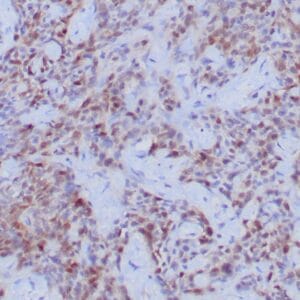
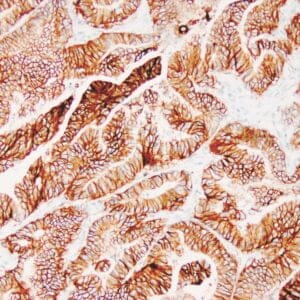
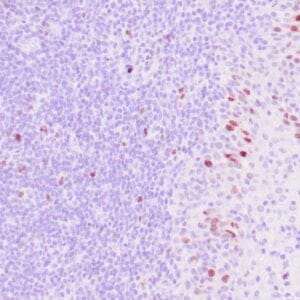
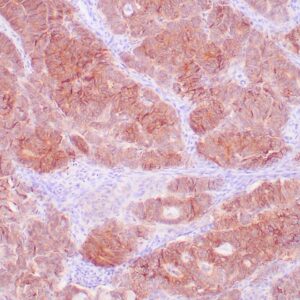
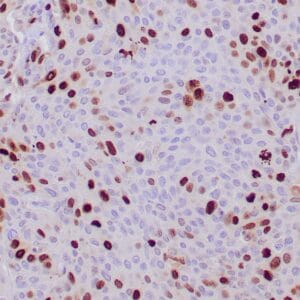


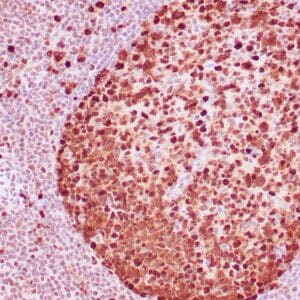
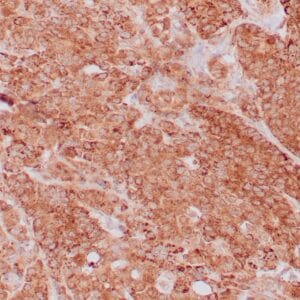


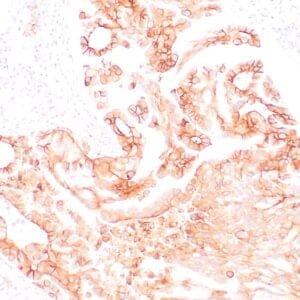
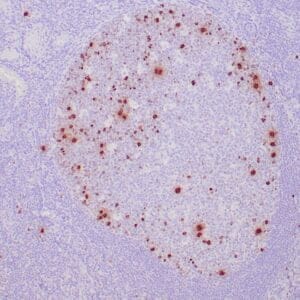

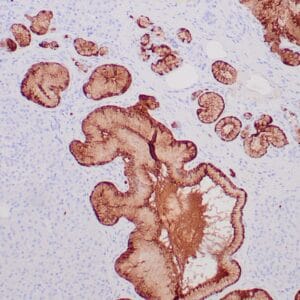
Reviews
There are no reviews yet.